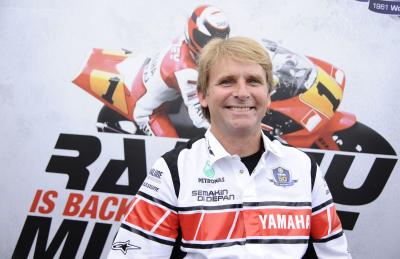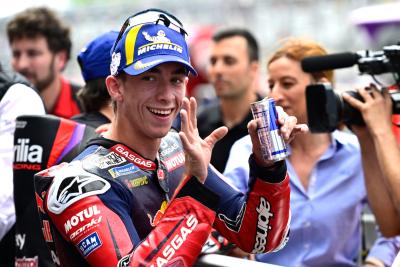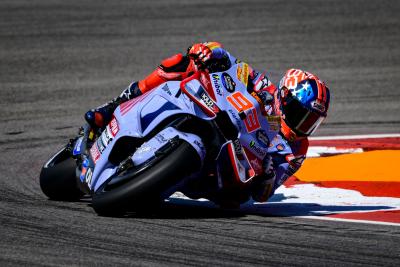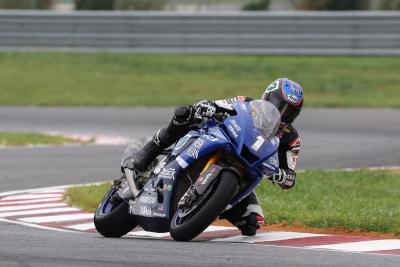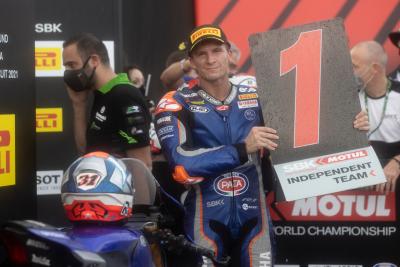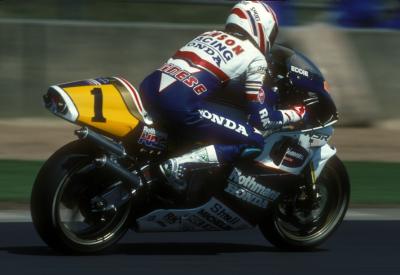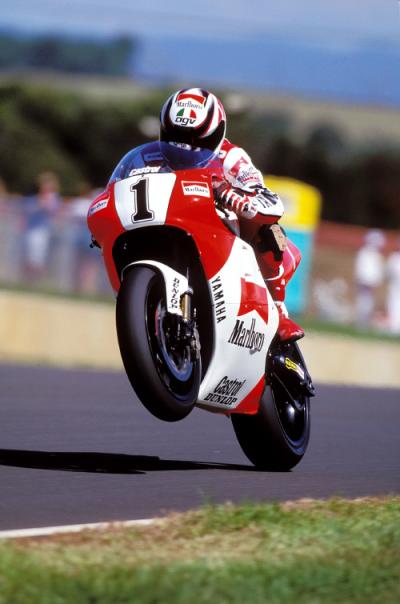Wayne Rainey
Personal Information

About Wayne Rainey
Wayne Rainey will forever be remembered as the triple world champion whose career was brought to a tragically early end by a paralysing crash at the 1993 Italian Grand Prix - while chasing his fourth world crown.
Career Stats
Latest News
Full Biography
Wayne Rainey will forever be remembered as the triple world champion whose career was brought to a tragically early end by a paralysing crash at the 1993 Italian Grand Prix - while chasing his fourth world crown.
All this at a time when MotoGP contained such legends as Mick Doohan, Kevin Schwantz, Wayne Gardner, Eddie Lawson and Randy Mamola. Rainey was the man they all needed to beat, despite riding an often underpowered Yamaha.
Before 2004, Rainey was the last rider to win the 500cc/MotoGP World Championship on a Yamaha, and following his cruel Misano crash went on to become a GP team owner for four years, running the likes of Norick Abe, Loris Capirossi and Jean-Michel Bayle.
A frightening determined rider, Wayne was one of the many American MotoGP heroes from the late 80s/early 90s who grew up in “So Cal” [South California]. Rainey, Lawson [two year's his senior] and many other motorcycle stars all honed their two-wheeled skills dirt track racing under the west coast sunshine at rough and ready local racetracks.
Many years later they would bring the spectacular rear wheel smoking style learnt at such venues to the European based GP series with great effect.
The Early Years.
Wayne was born on October 23, 1960, in Downey, California, the oldest of go-kart mad Sandy Rainey [a construction worker] and his wife Ila's three children.
His fathers love of all things motorised, combined with a desire to redesign almost everything he raced, soon rubbed off on Wayne, and when Sandy turned his attention to the new motorcycle craze sweeping the USA's west coast it wasn't long before he'd built his six year old son a 'minibike' to play around on…
...By the age of nine the undersized Wayne was racing at the emerging local dirt tracks [a mix of Motocross based bikes on Speedway type oval circuits, that sometimes contained jumps and kinks], built to feed the exponential off-road motorcycle rise sweeping the area.
The authorities didn't know it then, but these kids that raced just about every night of the week at such circuits [set-up mainly to keep them from riding on the streets] would one day rule the motorcycling world.
Rainey quickly advanced through the amateur dirt track ranks, eventually moving up to a 125cc two-stroke Yamaha by the age of 15 and winning just about everything he entered in So Cal. It was soon time to take on the other districts of the western state some of which were arguable even more competitive than the south, and he soon earned a name for himself among the racing set.
When he hit 16 year's old [in 1976], Rainey was old enough to race in AMA competition the route to national and international stardom. At this stage his sights were still set on dirt track glory and climbing the ladder to the prestigious 750cc AMA Grand National championship, where speeds topped 120 mph. He reached Grand National level at 18.
His first year in the championship came as something of a shock to the constantly winning Rainey; suddenly he was up against the best dirt track riders in the country, and his small size was a distinct disadvantage when it came to hauling the 750s around the ovals. His first season also ended with an out of character crash at the San Jose Mile and for the first time in his career he was hurt.
Rainey tangled with a fellow rider and hit the retaining fence hard injuring his back and heart. It would take two months for him to recover from a crash that had severely shaken his once steady confidence, he would be a top ten rider over the next few seasons, but for the first time ever he wasn't winning.
Amazingly, given his career achievements, he would never win a Grand National event.
Introduction to Road Racing.
By the age of 21, Rainey was getting increasingly frustrated at his lack of dirt track victories, and with Lawson [now turning heads riding for Kawasaki in AMA SBK] suggesting they hire Wayne as the next up and coming dirt tracker who could make the move across to road racing.
Kawasaki, spurred on by Lawson's results, offered Rainey the chance to ride semi works Team Green machines and he took to the tarmac like a duck to water, despite not even owning a road bike.
Wayne was an immediate winner in club racers, convincing the American arm of the Japanese manufacture and many others - that he was 'the next big thing'.
Superbike stardom.
As a result of his privateer performances on 250cc machinery, Rainey was offered a works 1000cc Kawasaki for the 1982 AMA Superbike championship, as team-mate to reigning champ Lawson.
Lawson went on to win the '82 title, but Rainey quickly learnt from him what it took to be a top class road racer. He finished fifth in his race debut at Daytona, won his first SBK race at Loudon that year, and finished third in the point's standings all while developing his distinct dirt track influenced rear wheel sliding style.
Rainey stayed with Kawasaki for the 1983 season, but with Lawson having stepped up to Grand Prix racing as Kenny Roberts' team-mate, Wayne was now partnered by the experienced Mike Cooley on the new 750cc machines.
Wayne soon overcame his team-mate, and the Honda led competition, winning six races and taking his first major title. Then the shock: Kawasaki were pulling out of motorbike racing, new champ Rainey was now without a ride.
But salvation was around the corner: 'King' Kenny Roberts, recently retired from racing, called Rainey and offered him the chance to ride for his new 250cc Grand Prix outfit, running privateer Yamahas. Rainey took the GP offer, it seemed like a dream chance and anyway he had little other options, but it would soon turn into a nightmare.
1984 In at the deep end with 250 GPs.
The rushed GP deal saw Rainey ride alongside Brit Alan Carter on a Marlboro sponsored Yamaha 250cc two-stroke. However, unlike the mighty Marlboro Yamahas seen in MotoGP in later years, these were 'bog-standard' and not even the famous Team Owner could persuade Yamaha to part with trick parts to make the bike more competitive.
As a result of this - and Rainey's lack of two-stroke experience - he would end the year eighth overall in the points standings, with a best finish of third at Misano [the scene of his career ending crash nine years later].
The year was okay, but the reigning American SBK champ had never been used to doing okay.
1985 to 1987 Formula One, Formula two, Superbike and Schwantz.
After a frustrating season in GP racing, Rainey returned to America to regroup. Both he and Kenny knew only a top class outfit could win at world level and both parted amicably to pursue their respective goals of Team Owner and Rider respectively but would re-unite, with devastating effect, from the 1988 500cc GP season onwards.
But for now, Wayne took a offer to race in the AMA Formula One championship [for GP type machinery] on a Honda RS500, and in the Formula Two championship on a 250cc two stroke.
Although considered a double title favourite, the '85 season was a frustrating one for Rainey as reliability blighted his chances in both championships. He would finish eighth overall in Formula One [taking two wins] and third overall in Formula Two [despite taking five wins].
For '86 the Formula One and AMA SBK championships were combined under the Camel Pro Series banner. Rainey raced a Honda VFR in the SBK races and the RS500 in the Formula One rounds, with both counting towards the overall crown.
Wayne won six of the nine Superbike races and one of the eight F1 rounds, but finished second overall due to his large amount of DNFs in the Formula One series.
In 1987, Rainey could concentrate solely on the AMA Superbike championship, which was now, thankfully, the top road racing championship in America and there would be none of the combined results saga from the '86 season.
Wayne was now desperate to make a point; he'd lost out on a title for the past two years despite being quick enough to win many races more than the eventual champions. For his own peace of mind as much as anything, he had to have the '87 SBK crown and no-one was going to stop him.
But one man disagreed.
Kevin Schwantz had raced with Rainey since '85 when Wayne had returned home from GPs, but with Schwantz still learning his trade the two hadn't had cause to tangle on track. However, the Texan was improving rapidly and by '87, with the support of Suzuki, he had his sights set on the AMA SBK crown.
The two were set for a collision course, both on and off track, as they fought for the title they both desperately needed to further their careers: Rainey started the year perfectly with wins at Daytona, Atlanta and Brainard, before Schwantz struck back with a superb string of five victories from the final six rounds but Rainey took the title.
He'd learnt from the previous seasons that wins were no use if you DNF'd too often, so he kept collecting the points, while Schwantz desperate to win at all costs kept crashing out.
However, the off track bitching between the two, only fuelled by Rainey taking the title, but Schwantz the most wins, would last for their whole racing career. Even when they both graduated to the greatest prize in motorcycle racing the next year: the 500cc World Championship.
Now the rivalry would go global.
1988 Team Roberts return on Lucky Strike Yamahas.
The timing was perfect for a return to GPs in 1988: Kenny Roberts was now running the factory Yamaha 500cc team and wanted Wayne back, while Rainey himself had finally restored his self belief with another AMA crown and needed a new challenge.
Oh, and Rainey wasn't going to let Suzuki's World Championship rookie Schwantz steal the GP limelight after their bitter '87 domestic season.
But that wasn't the only rivalry Rainey would be renewing, long time friend Eddie Lawson, now on a Marlboro Yamaha, had made good in Grands Prix, and was a double world champion by the time Rainey arrived at the sister works outfit, while if he wanted the world crown he would also have to overcome the Rothmans Hondas of 1987 world champ Wayne Gardner and his up and coming team-mate Mick Doohan.
Rainey was teamed with new Aussie sensation Kevin Magee, who had secured a factory ride after impressing in just a few wild-card outings the year before. Having had the experienced Randy Mamola [who moved to Cagiva] and Mike Baldwin on their books the previous year, Team Roberts appeared to be taking a considerable gamble on the GP new boys.
But it was another new boy who triumphed in the 15 round season opener much to Rainey's disgust. In appallingly wet conditions at Suzuka, Schwantz set the GP world alight by winning on his debut, and in front of the Japanese bosses.
Despite all his pre-season work and determination to make his second stab at GPs successful, Wayne crashed at Suzuka and would remount to finish sixth was the GP jinx back?
But round two was on home turf at Laguna Seca, and Rainey got his revenge - his first GP pole position, followed up by a fighting fourth placed finish [one place ahead of Schwantz] proved he had what it took, if he could just continue improving at that pace...
Next time out at the Spanish GP it would be Team Roberts that triumphed but it wasn't Wayne that took his first GP victory, instead amiable team-mate Magee stole the glory, which did little for any hopes Rainey's had of building the team around him.
Fortunately for Wayne, the turning point would come next time out at Jerez, when he lost out on victory to Lawson after hitting tyre problems, but held on to beat Magee after an almost race long battle.
Thereafter, Rainey proved he was the a potential championship contender, with a string of consistent top seven points finishes in the next seven rounds leading up to Donington Park and the British Grand Prix, with only Lawson and Gardner now ahead of him on points and duelling for the championship.
At Donington, Rainey qualified fifth, but made a strong start to lead out of Redgate and down the Craner curves he never looked back, and took his first GP victory in convincing style.
While he wouldn't repeat that victory in the remaining three rounds, he claimed another podium finish in Brno and ended the year third overall, ahead of both Magee and Schwantz. More importantly, he knew he had what it took to take the title.
1989 Refining the Rainey style.
1989 saw stability for Rainey, who remained with Roberts [indeed he would do so for the rest of his career], who in turn kept Lucky Strike and Magee on board and ran factory Yamahas on Dunlop tyres. Lawson, by contrast, had taken his #1 plate to Honda.
Wayne had thrown himself into pre-season testing in his usual thorough manner, and by the time of the Suzuka season opener, had built up an intimate knowledge of his YZR V4. Nevertheless, in a repeat of the previous year he was defeated by Schwantz after a bitter race long battle.
On to Australia and Rainey instantly took a liking to the fabulous Phillip Island circuit, but home hero Gardner rose to the occasion and nipped victory from him after a fantastic fight, but Rainey now led the championship.
The US GP was up next and what should have been a perfect result Rainey having won from Schwantz in front of their home crowd turned into a nightmare as Wayne's best friend, Bubba Shobert, and his team-mate Magee were involved in a freak post race accident that would end one of their careers.
It occurred after Rainey had taken victory, and on the slow down lap: Magee had been running out of fuel for the last few laps and so pulled over to do an 'angry' burn out for the crowd. Behind him, Shobert was shaking hands with Lawson and not looking ahead of him Bubba then struck the stationary Magee, breaking the Aussie's ankle and putting him in a coma. Shobert would recover, but never race again.
While Wayne reeled from his friends crash, Lawson won next time out to trim Rainey's points lead and shape the title up as a square two way fight after shadowing Lawson's career for so long, Wayne was now racing him for the World Championship.
Rainey shocked Lawson by winning at Hockenheim, and defeating Honda horsepower, then took his third and final victory of the year on the Assen roads. But then things started to go wrong.
Schwantz remained a threat, but his wild style led to inconsistency and while he could rob the top two of points he DNF'd too often to challenge for the crown. By contrast, Lawson was a seasoned veteran; he rarely fell even under the most extreme pressure and hauled points at every race.
This obviously didn't matter when Rainey was winning, but from Assen onwards [the final six rounds] he couldn't match his fellow American and a crash at Sweden, through desperation to regain his race winning form, effectively ended his hopes of taming Lawson, and Eddie took his fourth and final - world title at the season finale in Brazil.
1990 King Kenny's Dream Team.
For the 1990 season, Roberts managed to sign reigning champ Lawson to race alongside Rainey for a Marlboro backed 'Dream Team'. Rainey was out for revenge after the bitter disappointment of 1989, but had to contend with not only Lawson, but also the teams switch to Michelins.
For the first time Wayne won the opening Japanese Grand Prix, then at Laguna Seac events swung further in Rainey's favour [although not in a way he would have liked] when Lawson was forced to bail off when his brakes failed breaking his foot.
Rainey won the race despite Schwantz's best efforts and with his team-mate temporarily out of action, Rainey set off on a magnificent run of top three finishes over the next 11 races including a further five wins by the time he clinched the title [two races early] in Brno.
Lawson left the team at the end of the year to join Cagiva, and his season was tainted by allegations of sour grapes when he left Brno as soon as the race finished without taking his place on the podium alongside new champ Rainey. It seems that for a fierce competitor like Lawson it was just too painful.
1991 The Evil Empire grows.
Such was the awe in which the Roberts/Rainey/Marlboro/Yamaha combination was held that the team soon earned the nickname 'The Evil Empire' which seemed to sum up quite well their world dominating reign.
Despite the massive depth of quality in GP racing at the time that included Lawson, Spencer, Gardner, Doohan and Schwantz 'The Empire' started the year as favourites, despite the switch back to Dunlops.
Replacing Lawson at Team Roberts was cocky young American John Kocinski, who had graduated to the top class after winning the 250cc GP championship the year before. Kocinski wasn't prepared to spend the year learning and didn't hide his championship intentions. Another showdown was on the horizon.
A close season opener at Suzuka was won by Doohan, with Schwantz second then Rainey and Kocinski. Victory followed in Australia, but Doohan was fast emerging as a title challenger - his speed and consistency almost a match for Rainey's.
With Laguna up next, the Roberts team-mates were set to fight for home pride at a track both knew well - had Kocinski managed to take his maiden GP victory in the USA it would have put Rainey firmly on his back foot.
However, that's not what happened. Wayne took pole and ran away with the race, while Kocinski crashed trying to catch him. The psychological race between the team-mates had been won; it was now Rainey vs. Doohan [still on Michelins] for the world title.
Rainey wouldn't win again until round eight at Jarama by which time Doohan had taken the points lead, with the wild Schwantz grabbing several race wins. Next time out at Assen, Wayne lost out to Schwantz after a last lap crash, but recovered to take second Doohan meanwhile had been hit by his Assen curse and crashed out of a race he would always hate. In effect, the Aussie's title charge was over.
But it was far from plain sailing for Rainey, he didn't win another race that year but his string of podium finishes meant he clinched the crown at the penultimate round in France. Good job too, he broke his leg badly while testing for the final race at Malaysia with Wayne and Schwantz [also injured] absent, Kocinski took his first GP victory.
1992 Overcoming the odds.
The leg injury was a serious one and required major reconstructive surgery that even when finished meant Rainey struggled to walk. Nevertheless, the 32-year-old double world champion was determined to continue his rigorous pre-season testing schedule [partly to reacclimatize to Michelins] as he chased the chance to match team boss Roberts' three consecutive 500cc crowns. Kocinski remained his team-mate.
Wayne's lack of fitness soon caught him out and a pre-season testing crash meant his left little finger so badly damaged it had to be amputated. And overcoming injury wasn't the only uphill struggle he faced...
The season would consist of a reduced 13 rounds, starting in Suzuka and ending in South Africa at the end of September, and when he arrived at the season opener at Suzuka the GP paddock was stunned by the race debut of the revolutionary 'Big Bang' Honda NSR which swept to victory at the hands of Doohan, while unfit Rainey [he'd effectively lost the use of one leg and one hand] crashed out.
'Mighty Mick' continued his run with victories at Australia, Malaysia and Jerez to build up a commanding lead in the title chase. As if things get any worse for Wayne, he crashed out of the next round in Italy. A major rethink was needed if Rainey was to halt the Honda riders charge and not just by Wayne the Yamaha needed development if it was to catch Doohan's Rothmans rocket.
The turning point came at the next race in Catalunya, where Wayne caught and passed Doohan to finally open his '92 win account. The relief was short lived Rainey crashed at the following German GP... breaking his ribs.
The MotoGP circus left Hockenheim with Doohan a massive 65 points clear of Rainey.
Then came Assen.
Wayne was aching so much he didn't even start the Dutch TT but that wasn't the most significant event at the historic road circuit. Doohan's Assen jinx struck again and the Aussie suffered a leg breaking crash, which would see him hospitalised for months as he fought to keep the limb after poor medical advice and complications. But at that stage the full extent of his injuries were unknown, and a speedy recovery was expected by the GP paddock.
Rainey would have to overhaul the point's deficit before Mick's return.
Believing he had just a few races to cut Doohan's championship lead, Wayne gave his all despite his injuries to make sure he hauled points at every round. A fifth at Hungary was followed by victory in France, second in Britain, then the GP paddock went to the penultimate round in Brazil, with Rainey 22 points behind but with Doohan due to make his race return.
Despite his bravery, Doohan was a shadow of his former self and couldn't ride a push bike, let alone do battle on a 500cc GP machine, but he had to keep points from Rainey.
The race was a controversial one in the sense that some felt it was too dangerous and shouldn't go ahead [giving Doohan the championship]. However, the race was run and Wayne won easily, with Doohan [unsurprisingly] out of the points.
The two then started the decider at South Africa with Mick just two points ahead of Rainey.
Any thoughts of going through the motions were ended by Doohan out qualifying Rainey, but come race day at the high altitude race way and Rainey rode to a comfortable fourth while Doohan faded - but his time would come.
For now, a third consecutive world crown, and a place in the record books, was Rainey's.
Sure, he'd been lucky in the sense that Doohan had crashed at Assen, but then crashing, injury and motorcycle racing have always been inseparably linked. Rainey had also overcome the Hondas technical advantage and fought back from considerable injuries of his own. He was indeed a worthy champion.
1993 Schwantz, Doohan and disaster.
1993 saw Rainey stick with the Roberts Marlboro Yamahas, but he now had perennial crasher Luca Cadalora as his team-mate [Kocinski was back on a 250], and Kenny had switched his team back to Dunlop's.
Wayne knew he needed a considerable improvement from his Yamaha if he was to match the Doohan/Honda and a much more composed Schwantz/Suzuki combination, but would be left disappointed by the underpowered and ill-handling bike the Japanese marque presented him with.
Nevertheless, the Australian season opener began with a second, and Wayne followed that up with victories in Malaysia and Japan to take the points lead from Schwantz. More podium finishes followed over the next two rounds, but then the slump started next time out in Germany [round six], where the bikes deficiencies couldn't be masked and a fifth was all Rainey could salvage Schwantz had taken the points lead, and extended it with a win at Assen.
Rainey fought-back at Catalunya [round eight], where he won from Schwantz and Doohan, the sweeping corners reducing the need for all-out speed and allowing Wayne his third victory of the year. A third at San Marino was useful, but he again finished behind Schwantz and Doohan, and so gave the Suzuki rider further advantage.
But Donington Park would throw Rainey a GP lifeline when a multiple pile-up took out both Doohan and Schwantz [injuring his wrist], Wayne took second behind Cadalora and the championship momentum had swung strongly his way.
Rainey rode his new found confidence to a dominating victory at Brno, giving him the points lead and what would be his last ever Grand Prix victory, because following Brno was the fateful Italian Grand Prix at Misano.
Misano was a circuit Rainey had always liked, and a second placed starting position [behind Cadalora, but crucially ahead of Schwantz] put him in an ideal position to extend his points lead.
Rainey shadowed Cadalora from the start, but then with just over 10 of the 30 laps complete Wayne pitched his Yamaha into turn one a little too quickly. It wasn't a big mistake he was riding as hard as he could to pull away from Schwantz but then he accelerated a little too early on the exit for his out of line position and the bike stepped out at 120+ mph.
It didn't high-side him, but instead came back in to line with such ferocity that Wayne was thrown to the ground regardless. Rainey slid at high speed into the gravel, which perhaps crucially had been raked into deep ruts good at stopping cars, not so for unprotected motorcycle riders.
Rainey hit the raked gravel and was immediately sent into a sickening series of high speed somersaults, slamming him onto the rutted gravel time and time again before he eventually came to rest. His bike also appeared to strike him during the blurred TV replays.
Wayne's spine was broken midway down his back, severely. There was no chance of a full recovery and his life was in danger. It was only after a long hospitalisation that the bones in his back were corrected and repaired, but the severed spinal cord couldn't be.
It was the end of an era and shocked fans, riders and media alike. If it could happen to Rainey, it could happen to anyone.
In his absence, arch-rival Schwantz took his only World Championship, before Doohan began his fantastic run of five World Championships in a row before he, the last of the 'old boys', was forced into retirement by a crash at Jerez in 1999.
1994 to 1998 - Team Rainey.
Kenny Roberts, devastated at his friends paralysis, formed a 250cc GP team for Rainey that would run his son Kenny Roberts JR. [who would become the 2000 World Champion]. Thus, just months after his accident, Rainey was back in GPs albeit in a completely different role, running Marlboro Team Rainey.But it was a disappointing year, with KR Jr. injured and out of action for most of it.
Wayne now had his eyes on a 500cc team and acquired the services of wild [in every way] card star Norick Abe.However, Kenny snapped up Abe for his GP team [on loan from Rainey], while Wayne was left to run Harada and Kenny Jr in 250s in 1995. Harada won one race, but it was Biaggi's year.
1996 saw Rainey move to 500cc racing, with the up-and-coming Loris Capirossi, while still running Harada in 250s. The year started well, but Harada couldn't consistently challenge Biaggi. In the 500s, Capirossi ended the year with a benchmark [if lucky] victory, when Repsol team-mates Doohan and Criville knocked each other off. Despite the victory, Capirossi left the team and returned to 250s at the end of the year. More importantly for Rainey, Marlboro money left as well [for Kenny Roberts' new Modenas team].
1997 saw Abe finally ride for what was now Yamaha Team Rainey, with Spaniard Sete Gibernau his team-mate on 500cc YZRs. Abe finished the year seventh in the point's standings, with his best finish a third at Phillip Island. Gibernau managed thirteenth after a difficult debut year.
Abe and Rainey stayed together for the 1998 season, but Gibernau moved to Honda, and was replaced by off-road ace Jean-Michel Bayle. Abe improved his overall points position to sixth, and took three podium finishes, but was still a little wild setting a stunning pace, but often crashing as a result of it. Despite his efforts, Bayle struggled to adapt to world championship pace on tarmac and ended the year in sixteenth place.
But regardless of the on track performance, which certain wasn't disastrous, Wayne was never really happy and in 1998 retired fully from GP's to spend time with his family at their California home.
However, his love of speed never left him and he was given a specially designed go-kart so that he could still enjoy the thrill of speed...
...it was a present from long time friend, and one time rival, Eddie Lawson.
Wayne Rainey Main MotoGP achievements:
- 500cc Grand Prix starts: 83
- 500cc Grand Prix victories: 24 [29% win rate]
- 500cc Grand Prix podiums: 64
- 500cc Grand Prix Pole positions: 15
- 500cc World Championships: 3 [90, 91 and 92]
Latest Photos
